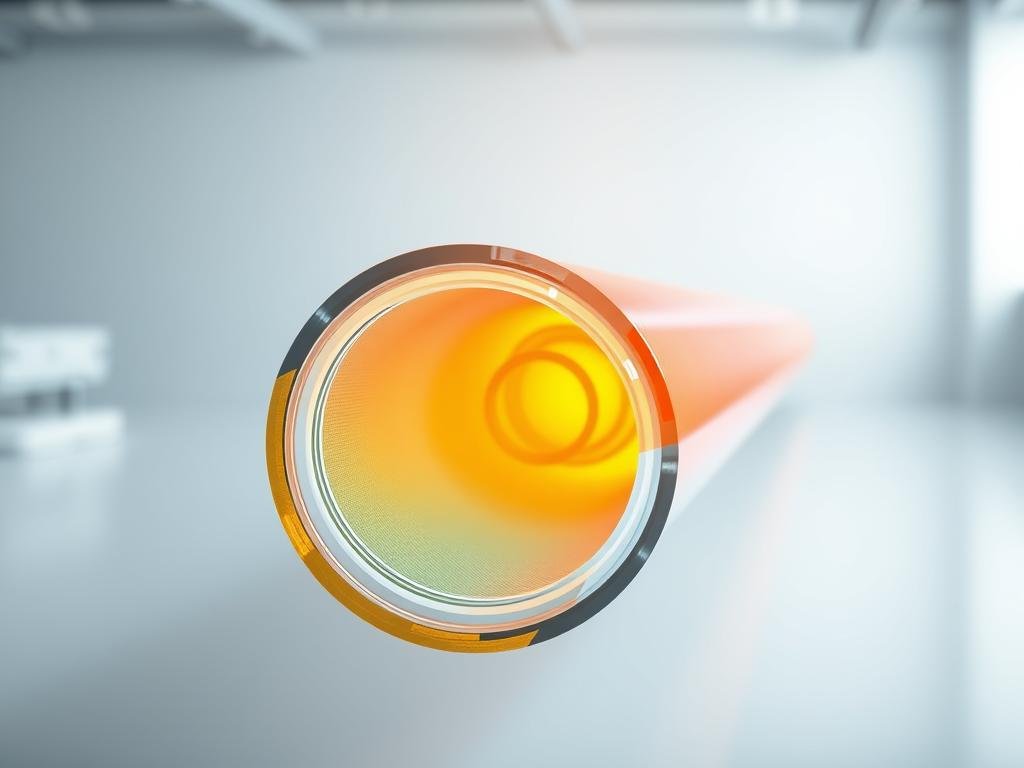Polyvinyl chloride, a versatile thermoplastic, plays a significant role in various industrial and commercial sectors. Its 熱性質 allow for effective processing and shaping.
The 熔點 of this material ranges between 160°C and 210°C, with some applications specifying it at around 170°C. Understanding this temperature range is crucial for safe and effective applications.
By knowing the heat limits of this widely used material, manufacturers and users can optimize processing techniques and prevent material degradation, ensuring the longevity of products.
Understanding PVC: Properties and Characteristics
PVC的獨特特性,例如其耐用性和抗化學性,促使其被廣泛使用。要充分了解PVC的能力,必須深入探討其基本特徵。
聚氯乙烯是什麼?
聚氯乙烯,或稱PVC,是一種以其多功能性著稱的塑膠材料。它是一種熱塑性塑膠,意味著它可以多次加熱融化並重新成型,而不會發生顯著的化學變化。這個特性使PVC非常適合各種加工技術。
PVC的物理性質
PVC exhibits a range of physical properties that make it suitable for different applications. It is known for its rigidity, durability, and resistance to abrasion and chemicals. The material’s state can vary from rigid to flexible, depending on the additives used during processing.
Crystallinity and Structure
The crystallinity of PVC significantly influences its properties. PVC has a semi-crystalline structure, with both crystalline and amorphous regions. The degree of crystallinity typically ranges from 5-15%, which affects its processing characteristics and mechanical properties.
PVC的可調結晶度有助於其多功能性,特別是在窗框等應用中。利用動態差示掃描量熱儀(DSC),可以通過測量材料在受控溫度變化過程中的吸熱或放熱來精確確定PVC的結晶度。
| Property | 描述 | 對PVC的影響 |
|---|---|---|
| 結晶性 | 半結晶結構,具有晶體區域與非晶區域 | Affects processing and mechanical properties |
| Degree of Crystallinity | 通常範圍為5-15% | Influences rigidity and flexibility |
| 處理條件 | Includes cooling rates and temperature profiles | Significantly influences final crystalline structure |
The PVC Melting Point: Temperature Ranges and Behavior
PVC’s melting characteristics play a significant role in defining its heat limits and processing conditions. Understanding these thermal properties is essential for the safe and effective application of PVC in various industries.
Defining Melting Point for Thermoplastics
The melting point of a thermoplastic, such as PVC, is the temperature at which it transitions from a solid to a liquid state. This 融化溫度 is critical for processing, as it determines the temperature range within which the material can be molded or shaped.
PVC的標準熔融範圍
PVC typically has a melting range rather than a sharp melting point due to its partially amorphous structure. The melting range for PVC is generally between 100°C to 260°C, depending on its formulation and the presence of additives or plasticizers.  This broad range allows for various processing techniques, from injection molding to extrusion.
This broad range allows for various processing techniques, from injection molding to extrusion.
玻璃轉變溫度與融點
The glass transition temperature (Tg) of PVC, typically ranging between 70°C and 90°C, is distinct from its melting point. At temperatures below Tg, PVC is rigid and glassy, while above Tg, it becomes more flexible and rubbery. Understanding both Tg and the melting point is crucial for processing PVC, as it must be heated above Tg for forming but below its degradation temperature. Key differences include:
- The glass transition temperature marks a change in mechanical properties without a phase change, unlike the melting point.
- 對於PVC的非晶區域,Tg尤其重要,因為這些區域並不具有真正的熔點。
- The temperature range between Tg and the melting point represents the processing window for PVC.
By understanding these thermal properties, manufacturers can optimize PVC processing conditions to achieve the desired product properties.
Factors Affecting PVC Melting Temperature
PVC的熔點受到多個關鍵因素的影響。了解這些因素對於優化PVC的加工與應用至關重要。
Molecular Structure and Weight
The molecular structure and weight of PVC significantly impact its melting behavior. PVC is a thermoplastic polymer, and its molecular weight distribution affects its melting characteristics. Generally, PVC with a higher molecular weight tends to have a higher melting temperature due to the increased entanglement of polymer chains.
Impact of Additives and Plasticizers
添加劑和塑化劑在改變PVC的性質方面扮演著關鍵角色,包括其熔點。例如,塑化劑可以通過增加聚合物鏈間的自由體積來降低PVC的玻璃轉變溫度和熔點。所使用的添加劑種類和用量會顯著影響最終產品的熱行為。
Processing Techniques and Their Influence
加工技術,例如擠出、注塑和吹塑,也會影響PVC的熔點。在這些過程中的加熱溫度和時間可以改變材料的結晶度,從而影響其熔融行為。先進的加工技術,如反應擠出,還可以進一步改變PVC的化學結構,製造具有特定應用所需熔融特性的材料。
By understanding and controlling these factors, manufacturers can optimize PVC processing to achieve desired material properties and performance.
Different Types of PVC and Their Heat Limits
不同類型的PVC被設計用來承受特定的溫度範圍,使它們非常適合各種用途。PVC配方的變化滿足不同的應用需求,從建築到工業流程。
Rigid PVC (uPVC) Melting Characteristics
剛性聚氯乙烯(PVC),也稱為未增塑聚氯乙烯(uPVC),其熔點較其增塑版本更高。它的熔點通常在160°C到210°C之間。uPVC中缺乏增塑劑,這有助於提高其耐熱性,使其適用於管道和窗框等應用。
Plasticized PVC (pPVC) Heat Behavior
Plasticized PVC (pPVC) contains additives that enhance its flexibility. However, this flexibility comes at the cost of reduced heat resistance. pPVC generally has a lower melting point than uPVC, typically ranging from 150°C to 180°C. Its applications include flexible tubing and certain types of flooring.

CPVC: The High-Temperature Alternative
氯化聚氯乙烯(CPVC)是一種特殊的聚氯乙烯,因其額外的氯含量而具有較高的耐溫性。CPVC的熔點範圍為230°C至260°C,非常適合用於高溫水管和熱水系統。其增強的耐久性和化學抗性使CPVC成為標準聚氯乙烯無法勝任的應用的首選。
- CPVC 能承受高達 95°C (203°F) 的連續運行溫度,適用於熱水管路系統。
- CPVC製造中的後氯化過程會增加其氯含量,從根本上改變其熱性質。
- CPVC 在腐蝕性環境中保持優異的耐久性,這得益於其增強的化學抗性。
基於耐熱性的PVC應用
了解PVC的耐熱極限對於選擇適合特定用途的材料至關重要。PVC的耐熱性在決定其適用於各種應用中的角色中扮演著關鍵角色,從建築和管道到工業流程。
建築與管線應用
在建築和管道工程中,PVC因其耐用性和抗腐蝕性而被廣泛使用。PVC管材和配件設計能夠承受各種溫度,適用於熱水和冷水系統。
PVC 管道系統與溫度限制
PVC管系統常用於管道和灌溉。然而,必須考慮其溫度限制,以防止變形或故障。PVC管的最高工作溫度通常約為140°F(60°C)。

工業用途與熱量考量
在工業環境中,PVC 被用於各種應用,包括化學處理、電氣絕緣和通風系統。在這些應用中,考慮 PVC 的耐熱限制至關重要,以確保安全可靠的運作。具有增強耐熱穩定劑的專用 PVC 配方可以用來延長材料的溫度範圍。
Industrial applications of PVC must carefully consider the material’s heat limitations, particularly in environments where process temperatures fluctuate significantly. Chemical processing industries utilize PVC piping and vessels, but must ensure operating temperatures remain within the material’s capabilities.
處理PVC:溫度控制與安全
有效的PVC加工取決於維持適當的溫度。這對於防止降解並確保成品的品質至關重要。
注塑成型溫度要求
PVC 注塑需要精確的溫度控制。PVC 注塑的理想溫度範圍通常在 350°F 到 400°F(175°C 到 205°C)之間。維持這個溫度範圍對於達到高品質的表面處理和防止缺陷至關重要。
Preventing Thermal Degradation
當PVC長時間暴露在高溫下時,可能會發生熱降解。為了防止這種情況,控制溫度和在螺桿中的停留時間是非常重要的。 退化 可能導致氯化氫的釋放,造成模塑件上出現黑色條紋或燒焦的斑點。
常見的熱相關問題與解決方案
在PVC加工過程中,可能會出現多種與熱相關的問題,包括燒焦、表面品質差以及尺寸不穩定。解決這些問題的方法包括優化模具溫度、改善冷卻通道設計,以及微調注塑機的溫度曲線。
- 炙熱和黑點可以通過降低槍管溫度或縮短停留時間來解決。
- 表面品質不佳可以透過將模具溫度提高到50-60°C(122-140°F)來改善。
- 尺寸不穩定性可以通過優化冷卻通道設計和一致的溫度控制來解決。
結論:透過溫度管理最大化PVC性能
了解PVC的熱極限對於最大化其在各行各業的潛力至關重要。有效 溫度管理 在PVC生命周期中始終確保最佳的材料性能、耐久性與安全性。PVC配方與熱行為之間的關係使製造商能夠為特定需求定制材料。 溫度要求PVC技術的進步持續擴展其 耐溫性 能力,開啟新應用,同時保持成本效益和多功能性。
隨著永續性問題的日益關注,了解PVC的熱性質有助於更高效的加工,並降低能源消耗。PVC應用的未來可能會持續在耐熱配方方面進行創新,進一步擴展這種多功能材料的用途。
